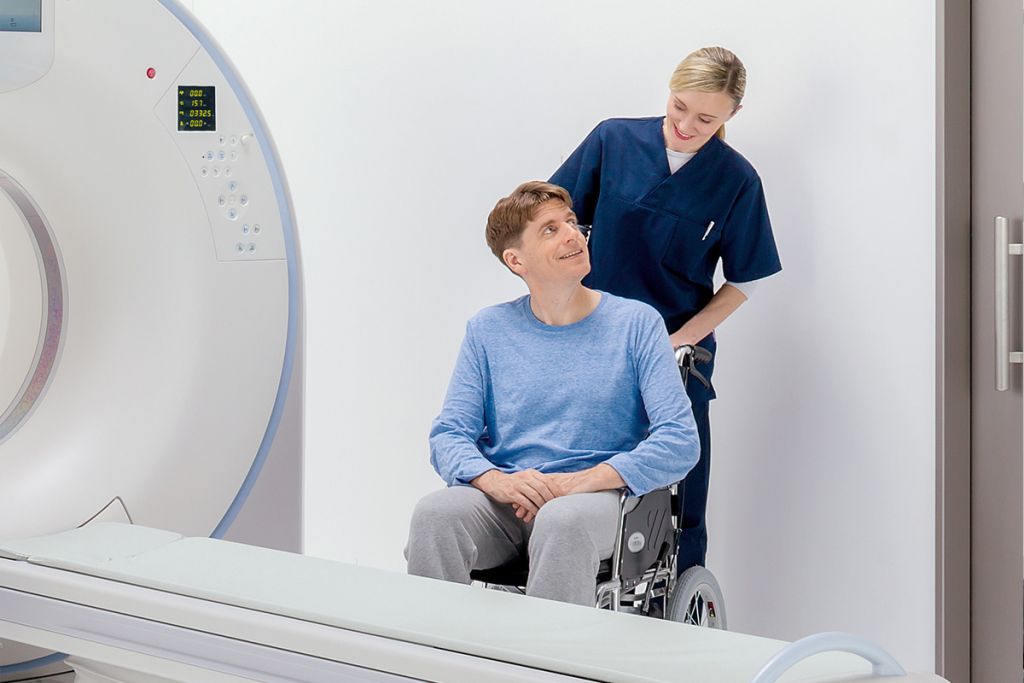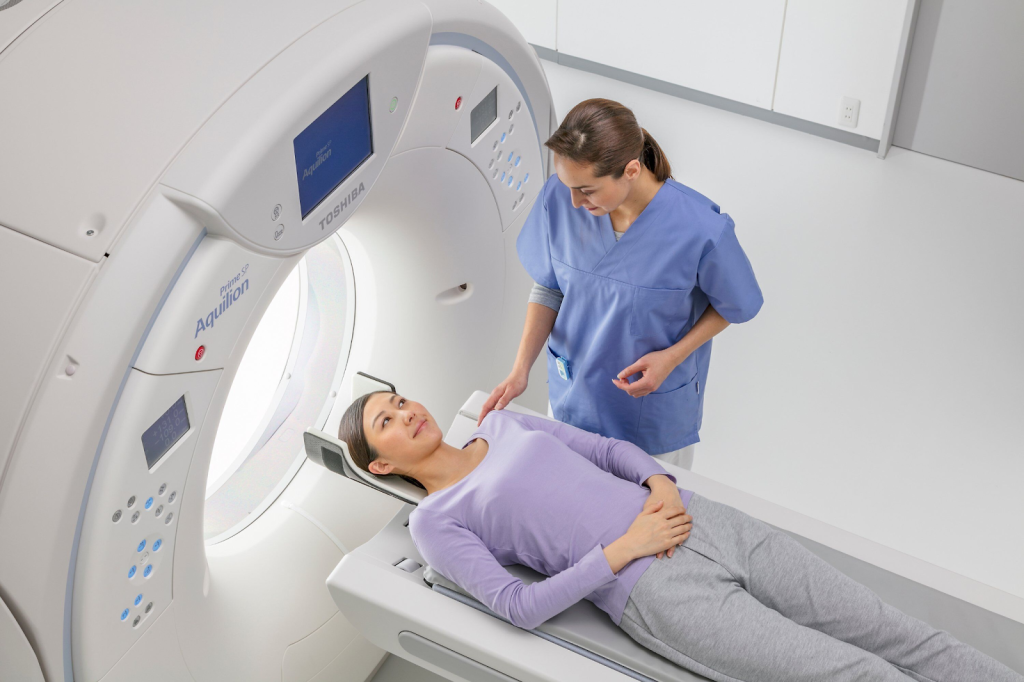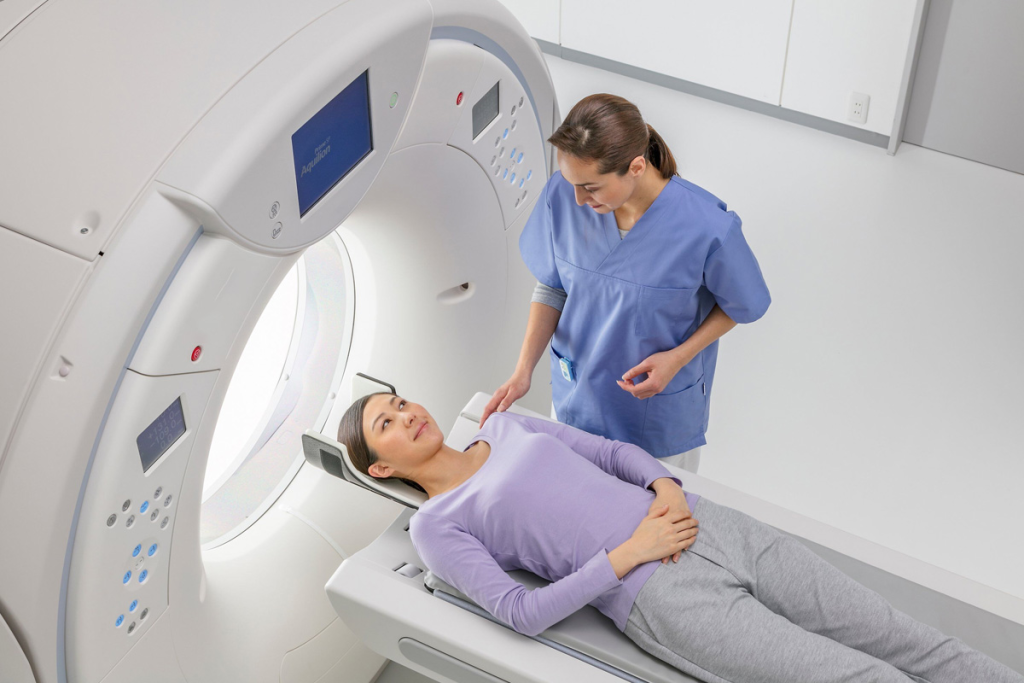
Finding the cause of chronic back pain is hard. It affects millions of people around the world. It’s tough to treat back pain because it’s hard to find what’s causing it.
A SPECT back pain scan is a tool that helps find the source of pain. It’s good at spotting problems like facet joint arthritis in people with long-term back and neck pain.
With a SPECT scan, doctors can understand where the pain comes from. This helps them make treatment plans that really work.
SPECT imaging is key for spotting spinal problems. It’s a way to see how the body works, focusing on bone activity. This helps doctors understand what’s going on inside.
Nuclear medicine uses tiny amounts of radioactive tracers. These tracers help find and treat diseases like cancer and heart issues. For back pain, SPECT imaging is great at showing bone activity.
First, a radiotracer is given. It goes to areas where bones are changing a lot. Then, the SPECT scanner picks up the gamma rays. This creates detailed images of the bones.
CT scans and MRI show the body’s structure. But SPECT looks at how the body works. It’s good for finding pain sources and seeing inflammation.
SPECT/CT fusion imaging adds more details. It mixes SPECT’s function with CT’s anatomy. This combo helps doctors plan better treatments.

SPECT scans are key in finding the cause of back pain. They show functional issues that other tests miss. This is important when other tests don’t show anything, but the pain persists.
Diagnosing back pain involves both doctor’s exams and imaging tests. X-rays, CT scans, and MRI show the body’s structure. But SPECT scans are better at finding the real pain cause.
SPECT scans are great at spotting spine problems like bone changes and inflammation. They look at how the spine works, not just its shape. This is a big plus for diagnosing spine issues.
For example, SPECT scans help with degenerative spine imaging. They show where the spine is working wrong. This helps doctors find the pain source and treat it right.
SPECT scans are also good at showing bone metabolism and inflammation. They use special tracers that light up where things are active. This helps find where the pain is coming from.
In spine arthritis imaging, SPECT scans show how bad the inflammation is. This info is key for diagnosing and checking if treatments are working.
| Condition | SPECT Scan Findings | Clinical Implication |
| Degenerative Disc Disease | Increased uptake in adjacent vertebrae | Indicates active inflammation and degeneration |
| Facet Joint Arthropathy | High tracer uptake in facet joints | Suggests active inflammation and potentially pain source |
| Sacroiliac Joint Dysfunction | Asymmetric uptake in SI joints | Indicates inflammation and dysfunction |
SPECT scans give a detailed look at spine changes. They help find the real cause of back pain. Their ability to spot problems and show inflammation makes them a must-have for spine exams.

Healthcare professionals use SPECT scans to find the causes of back pain. This helps them create better treatment plans. SPECT imaging is a key tool for diagnosing and managing spinal issues, giving insights that other tests can’t.
SPECT scans are great for finding the sources of back pain. They’re helpful when there are many possible causes. SPECT imaging lets doctors know exactly where the pain is coming from, so they can treat it more effectively.
SPECT scans are also good at telling old injuries from new ones. This is important for making the right treatment plans. SPECT imaging shows if an area of the spine is inflamed or degenerating.
Another big plus of SPECT scans is measuring inflammation. By seeing how much radiotracer is taken up, doctors understand the inflammation better. This helps them decide on treatments and check if they’re working.
In summary, SPECT scans are very useful for diagnosing and treating back pain. They help find pain sources, tell old from new injuries, and measure inflammation. This information leads to better treatment results.
SPECT/CT fusion imaging is a big step forward in diagnosing spinal issues. It combines SPECT scans’ functional data with CT scans’ detailed anatomy. This gives doctors a clearer picture of spinal problems.
By merging SPECT and CT, doctors can see both how the body works and its structure at the same time. This helps them understand spinal issues better. They can:
Experts say SPECT/CT is key for diagnosing and treating spinal problems. It gives doctors a unique view of both the body’s function and its structure. This helps them make better treatment choices.
This hybrid imaging modality has revolutionized the field of nuclear medicine, specially in complex spinal conditions.
SPECT/CT fusion imaging has many advantages for spine conditions:
In summary, SPECT/CT fusion imaging is a big leap in diagnosing and managing spinal issues. It offers a deeper understanding of the complex structures involved.
SPECT imaging is great at finding many back problems. It gives doctors the info they need to plan treatments. This is really helpful for dealing with tough spinal issues.
Facet joint arthropathy is a big cause of back pain. It happens when joints wear down or get inflamed. SPECT scans show where the joints are active because of inflammation or wear. This helps doctors know where to focus treatments.
Sacroiliac joint dysfunction can really hurt your lower back. It’s hard to figure out what’s wrong. SPECT imaging finds odd activity in these joints, showing if they’re inflamed or worn down. This helps doctors make better treatment plans.
Spinal stress fractures are hard to spot with regular tests. They happen when bones are weak or you’ve been very active. SPECT scans catch these changes early, so doctors can act fast.
When cancer spreads to the spine, it’s a serious issue. SPECT imaging can spot cancer in bones by seeing where bones are more active. This is key for figuring out how far the cancer has spread and what treatment to use.
| Condition | SPECT Scan Findings | Clinical Implication |
| Facet Joint Arthropathy | Increased uptake in facet joints | Targets for facet joint injections or denervation |
| Sacroiliac Joint Dysfunction | Abnormal uptake in SI joints | Guidance for SI joint injections |
| Spinal Stress Fractures | Localized increased uptake | Early detection and conservative management |
| Metastatic Disease | Multiple areas of increased uptake | Cancer staging and treatment planning |
Getting a SPECT scan for back pain involves several steps. This method is key for checking bone activity and finding pain sources. Knowing the process helps patients get ready for their test.
Before the scan, patients must prepare in a few ways. They might need to take off jewelry or metal items. This is to avoid any scan interference.
Patients also change into a hospital gown for comfort. Sometimes, they’re told to skip certain meds or foods. This is to get the best scan results. The prep is simple and aims to reduce any discomfort.
A radiotracer, a tiny bit of radioactive material, is injected into the patient’s blood. It goes to areas with high bone activity, like injuries. The most used radiotracer is Technetium-99m for bone scans.
The radiotracer is given through an IV. Then, patients wait a few hours for it to settle in the bones. This wait is key for clear images.
After waiting, the patient is ready for the scan. They lie on a table that slides into a big camera. This camera picks up gamma rays from the radiotracer to make spine images.
The scan takes 30-60 minutes. Patients must stay very quiet for clear images. The camera moves around the patient, capturing images from all sides. These images are then turned into a 3D spine picture, showing bone activity and pain sources.
Getting a SPECT scan for back pain might seem scary, but knowing what to expect can make it easier. A SPECT scan uses nuclear medicine to see how active the bones in your spine are. It’s a way to find out if there’s any pain or injury.
When you get a SPECT scan, it’s usually quick and doesn’t hurt. First, a tiny bit of radioactive tracer is put into your vein. This tracer goes to areas where your bones are very active, like if you’re hurt or inflamed.
Then, you lie on a table that moves into a big camera. The camera goes around you, taking pictures of your spine from different sides. It takes about 30-60 minutes, and you need to stay very quiet to get clear pictures.
To feel less anxious during the scan, try a few things. Breathing exercises and relaxation techniques can really help. Also, tell the person doing the scan if you’re feeling any pain or discomfort.
The room where you’ll be scanned has comfortable things to make you relax. Some places even play music or other things to distract you.
When we look at SPECT scan results, we focus on the uptake patterns. These patterns help us understand the patient’s condition. This is key for making the right diagnosis and treatment plan.
Uptake patterns in SPECT scans show where and how much of the radiotracer is in the spine. Abnormal uptake can mean there’s increased bone activity, inflammation, or other issues. It’s important to know what’s normal and what’s not.
Each spinal condition has its own pattern. For example, facet joint problems show up as high uptake in those joints. On the other hand, sacroiliac joint issues might show up in the sacroiliac joints. Measuring how intense the uptake is helps us see how severe the problem is.
Matching SPECT scan results with what the patient is feeling is key. Clinical correlation means comparing the scan findings with the patient’s symptoms and medical history. This helps us figure out the best course of action.
Let’s say a patient has lower back pain and the scan shows high uptake in the L4-L5 facet joints. This match helps confirm that the pain is coming from those joints. This insight helps us target the treatment more effectively.
By combining SPECT scan results with what the patient is experiencing, doctors can get a clearer picture. This leads to better management of the patient’s condition.
When back pain lasts for a long time without a clear reason, doctors might suggest a SPECT scan. This advanced imaging method is very helpful in certain situations.
For those with chronic back pain and no known cause, a SPECT scan can find the problem. It shows how active the bones and joints are. This can reveal issues that other tests miss.
In cases of failed back surgery syndrome, where pain persists after surgery, SPECT scans are very useful. They help figure out if the pain is from faulty hardware, scar tissue, or something else. This helps doctors decide what to do next.
SPECT scans are key in pre-surgical planning. They give detailed info on the activity of spinal parts. This helps surgeons know where the pain is coming from, which can lead to better surgery results.
For those needing injections for pain, SPECT scans help with targeted injection therapy. They pinpoint where the pain is. This makes injections more effective.
| Clinical Scenario | Benefit of SPECT Scan |
| Chronic Pain Without Clear Diagnosis | Identifies underlying metabolic abnormalities |
| Failed Back Surgery Syndrome | Differentiates between causes of persistent pain |
| Pre-Surgical Planning | Guides surgeons to primary pain generators |
| Targeted Injection Guidance | Enhances precision in injection therapy |
Many imaging techniques are used to diagnose back pain. SPECT scans are a valuable tool, giving insights that complement other methods.
MRI and CT scans are often used for back pain diagnosis. MRI shows soft tissues like discs and nerves well. CT scans focus on bones. SPECT scans, though, show bone activity and inflammation.
SPECT/CT fusion imaging combines these, making diagnoses more accurate.
SPECT scans are great for finding stress fractures, infections, or cancer in bones. This info is key for treatment plans.
X-rays are first used for back pain because they’re cheap and easy to get. But, they can’t spot early bone or soft tissue changes. Myelography gives detailed spinal images but is invasive and risky.
SPECT scans are non-invasive and show bone activity. They can spot issues not seen on X-rays or myelography. This is helpful for diagnosing facet joint or sacroiliac joint problems.
SPECT scans add to back pain diagnosis. They give functional info not seen in anatomical images. This helps doctors understand symptoms better.
Often, a mix of imaging is used for a full diagnosis. For example, MRI for soft tissues and SPECT for bone. This multi-modal approach leads to better diagnoses and treatment plans.
SPECT imaging is a helpful tool for diagnosing back pain. It shows how bones work and if there’s inflammation. But, like all tools, it has its good and bad sides.
SPECT imaging has many advantages for back pain. It’s great for finding the source of pain, telling old from new injuries, and measuring inflammation. For example, it can find active pain spots in chronic back pain.
In cases of facet joint arthropathy or sacroiliac joint dysfunction, SPECT can spot tiny bone changes. This is key for planning treatments like injections to ease pain.
But, SPECT imaging has some limitations. One big one is the radiation it uses. While it’s safe, it’s something to think about, mainly for young people or those needing many scans.
Another issue is its low spatial resolution. This means it’s hard to pinpoint exact problems, like in the spine. But, new SPECT/CT systems help by showing both function and anatomy at once.
In summary, SPECT imaging is a strong tool for back pain diagnosis. It gives insights into bone and inflammation. Even with its downsides, its benefits in certain cases make it very useful.
It’s important for patients to know about the costs of SPECT scans for back pain. The price can affect your health care choices and budget planning.
The price of SPECT scans for back pain in the U.S. changes based on several things. These include the place, location, and if other tests like CT scans are added.
| Procedure | Average Cost Range |
| SPECT Scan | $800 – $1,500 |
| SPECT/CT Scan | $1,200 – $2,500 |
These prices are just estimates. They can change based on the doctor’s fees and your insurance.
Insurance for SPECT scans for back pain varies. Most plans cover them if they’re needed, but how much they cover can differ.
“Insurance coverage for diagnostic imaging like SPECT scans is often contingent on the patient’s specific condition and the healthcare provider’s recommendations.” –
A healthcare industry expert
Patients should talk to their doctor and insurance to find out what’s covered. They should also know what they’ll have to pay out of pocket for SPECT scans for back pain.
The future of SPECT imaging in back pain looks bright. New technology and better diagnostic tools are on the horizon. SPECT/CT fusion imaging is becoming a key player in diagnosing and treating spinal issues.
SPECT imaging can show how bones work and if there’s inflammation. This helps doctors find the sources of pain and treat them directly. As technology gets better, we’ll see more accurate diagnoses and better treatments for back pain.
SPECT imaging’s role in managing back pain will grow. It will help doctors understand spinal problems better. This will lead to more effective treatments, improving the lives of those with back pain.
A SPECT scan is a test that shows how bones work and if they’re inflamed. It helps find the sources of back pain. This way, doctors can see what’s causing the pain.
SPECT scans look at how bones work and if they’re inflamed. MRI and CT scans just show what bones look like. SPECT scans can find problems that other tests miss.
SPECT/CT fusion imaging combines two tests. It shows how bones work and what they look like. This helps doctors understand spinal problems better and make better treatment plans.
SPECT scans can find many back problems. These include issues with facet joints, sacroiliac joints, stress fractures, and cancer in the spine.
To get ready for a SPECT scan, you might need to remove jewelry and metal objects. You’ll also get a special dye. Your doctor or the imaging center will tell you more.
During a SPECT scan, you’ll lie on a table that moves slowly. The scanner will look for the dye in your body. It’s painless and usually takes 30-60 minutes.
Doctors look at the scan results to see where bones are working too much or too little. They match this with your symptoms to find the problem.
A SPECT scan is suggested for back pain that’s hard to diagnose. It’s also used for failed surgery, planning surgery, and guiding injections.
SPECT imaging adds special information to what MRI, CT scans, X-rays, and myelography show. It helps doctors understand spinal problems better.
SPECT imaging finds problems that other tests might miss. But, it uses radiation and needs special equipment and experts.
Subscribe to our e-newsletter to stay informed about the latest innovations in the world of health and exclusive offers!
WhatsApp us